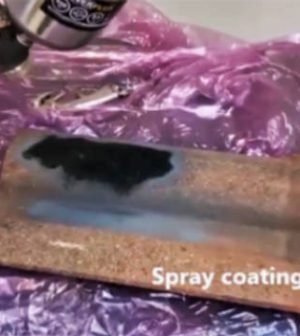Global S&T Development Trend Analysis Platform of Resources and Environment
| “Green” Adsorbent Reduces Pollution More Effectively than Activated Carbon | |
| admin | |
| 2018-04-19 | |
| 发布年 | 2018 |
| 语种 | 英语 |
| 国家 | 美国 |
| 领域 | 气候变化 |
| 正文(英文) |  Material can be applied in three ways: brushed on as a coating, sprayed on as a coating, or 3D printed. (Credit: Screen shot, Bontempi) When the EU challenged scientists like Dr. Elza Bontempi of the University of Brescia to come up with a greener option for cutting down on particulate matter (PM), they couldn’t have known she’d take them at word. Using sodium alginate extracted from algae and seaweed and the byproduct of a common industrial process, Dr. Bontempi has created a coating that can remove PM with 94 percent efficiency, even at high concentrations. Dr. Bontempi corresponded with EM about her research. Air pollution caused by fine particles (2.5 μg or less in diameter) is especially harmful, because the small particle size that characterizes fine PM can so easily penetrate human bronchi and lungs. “According to the European Environment Agency, 467,000 premature deaths in Europe were attributed to PM2.5 in 2013,” adds Dr. Bontempi. In 2015, the European Commission decided to stimulate research in the field of new materials designed to reduce the concentration of PM in urban areas. Their aim was to highlight innovative, affordable, and sustainable solutions, based on design-driven materials. “I started the work I presented in my paper in 2015 in response to the European Commission request,” details Bontempi. “It’s a new material for PM reduction, and it also shows interesting characteristics in terms of dye adsorption, making it applicable for wastewater treatment.” PM infiltrates air and wastewater in the form of droplets and particles emitted from vehicles, power plants, fires, and factories every year. Both organic dyes and PM are toxic to humans—and to entire ecosystems. The current state-of-the-art in adsorbents for removing them from both wastewater and air is activated carbon, but producing and regenerating it is costly, in more ways than one.  This is an overview of the study methods and results, which demonstrate a new low-cost, sustainable material for reducing air and water pollution. Credit: © 2018 Zanoletti, Vassura, Venturini, Monai, Montini, Federici, Zacco, Treccani and Bontempi. Front. Chem. “Most materials used today to remove PM are made by mining and processing minerals drawn from the planet’s mineral reserves,” Bontempi describes. “This requires energy, and that also means carbon emissions; more than 20% of all human carbon emissions is caused by materials production.” In this context the reuse of byproduct materials is fundamental. Bontempi and her team combined two materials that are naturally abundant: sodium alginate and silica fume, a byproduct of silicon or ferrosilicon metal alloy processing. “I have a lot of experience in fly ash,” Bontempi remarks, referring to the way she chose the materials to work with. “I worked for several years on the stabilization of heavy metals contained in fly ash derived from the municipal solid waste incineration process. In fact, the European Commission has already financed two of my research group’s projects on this subject.” The result is her “green” adsorbent that can be painted onto surfaces to absorb PM and then rinsed to regenerate. It is easy to synthesize, and simple to apply as a coating in several different ways, shown in the team’s YouTube video. All of these features make for a new, hybrid material that’s scalable and highly effective.
 Material can be applied in three ways: brushed on as a coating, sprayed on as a coating, or 3D printed. (Credit: Screen shot, Bontempi) “This is a composite material, so it can adsorb contaminants due to to the nature of its components; silica ash has good adsorption properties,” adds Bontempi. “In addition, the material is porous, with pores ranging from microns to nanometers. These pores can trap PM in air.” In water, the material is used in a slightly different way, consolidated with food-grade sodium bicarbonate which helps the alginate gel. The composite was able to remove high concentrations of the model pollutant, a methylene blue dye, from wastewater samples with 94 percent efficiency. “Honestly, I hope that this material will be applied to the external surface of buildings, to trap PM,” Bontempi states. “There are no other materials that can compare to this, for PM reduction in cities.” Bontempi should know; she wrote the book on sustainable materials, literally. Moving forward, she hopes other researchers will join the hunt for new materials. “We are open to all kinds of ideas, suggestions, and collaborations,” she adds. I hope research scientists and engineers won’t hesitate to contact me at: elza.bontempi@unibs.it”
|
| URL | 查看原文 |
| 来源平台 | Environmental Monitor |
| 文献类型 | 新闻 |
| 条目标识符 | http://119.78.100.173/C666/handle/2XK7JSWQ/114609 |
| 专题 | 气候变化 |
| 推荐引用方式 GB/T 7714 | admin. “Green” Adsorbent Reduces Pollution More Effectively than Activated Carbon. 2018. |
| 条目包含的文件 | 条目无相关文件。 | |||||
| 个性服务 |
| 推荐该条目 |
| 保存到收藏夹 |
| 查看访问统计 |
| 导出为Endnote文件 |
| 谷歌学术 |
| 谷歌学术中相似的文章 |
| [admin]的文章 |
| 百度学术 |
| 百度学术中相似的文章 |
| [admin]的文章 |
| 必应学术 |
| 必应学术中相似的文章 |
| [admin]的文章 |
| 相关权益政策 |
| 暂无数据 |
| 收藏/分享 |
除非特别说明,本系统中所有内容都受版权保护,并保留所有权利。
修改评论